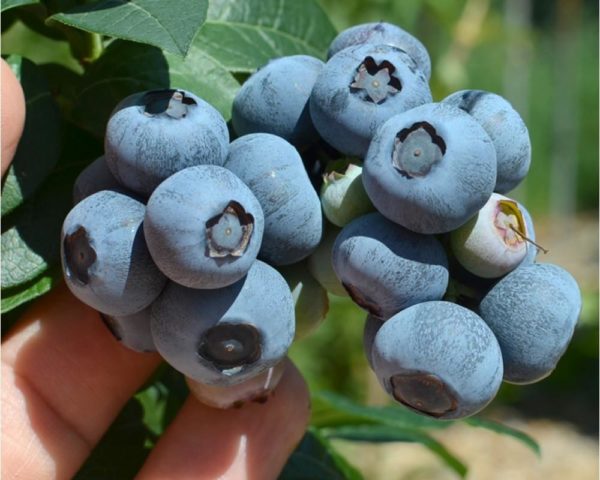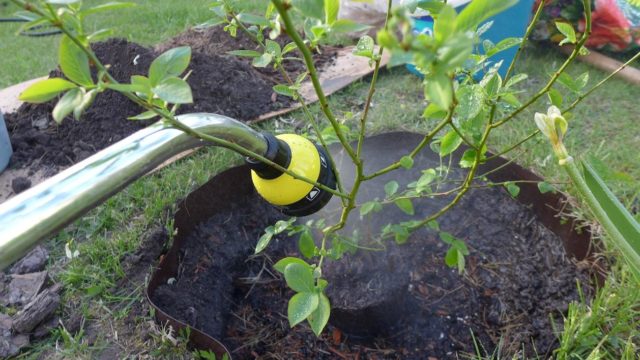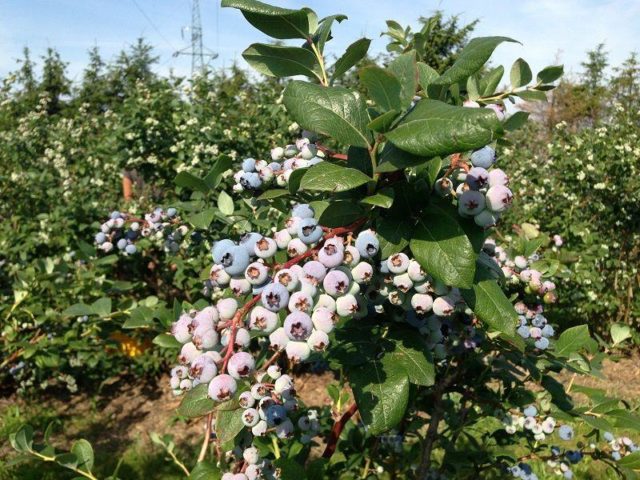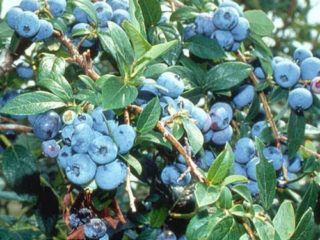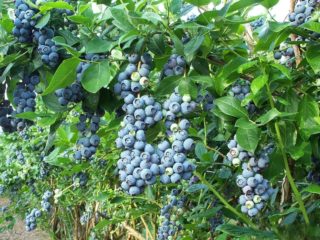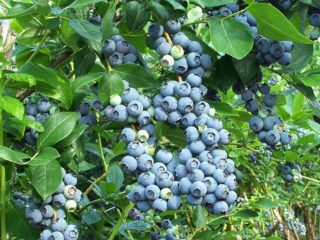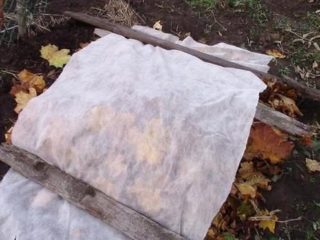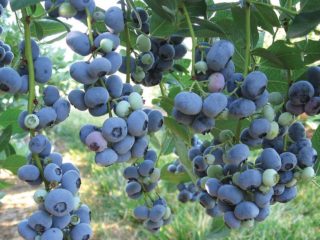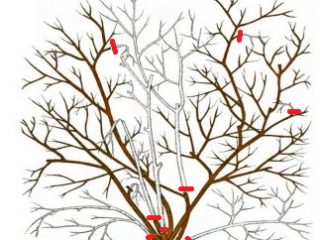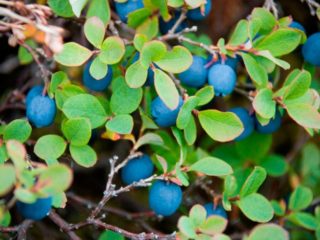Content
Nelson blueberries are an American variety developed in 1988. The plant was bred by crossing Bluecrop and Berkeley hybrids. In Russia, the Nelson variety has not yet been tested for inclusion in the State Register. However, the crop is considered promising for cultivation in various regions.
Description of blueberry variety Nelson
Nelson blueberry is a vigorous shrub that can grow up to 1.5 - 1.8 m in height. Its shoots are straight, raised, numerous. Young shoots are green; over time, the bark becomes gray or brownish.
The leaves are smooth, alternate, hard, up to 2.4 cm long. Their shape is lanceolate, with a rounded tip. The edges of the leaf plate are slightly curved down. The color is bluish-green, lighter on the reverse side. The leaves have a light waxy coating.
The flowers are located on last year's shoots, collected in loose clusters. The calyxes are bell-shaped, drooping, white-pink in color. Flowering begins in the second decade of June and lasts 10 - 12 days.It takes 40-50 days for the berries to form.
Features of fruiting
Nelson blueberries are self-fertile and can produce without a pollinator. To improve its fruiting, other varieties are planted nearby. A prerequisite is flowering at the same time. For Nelson blueberries, hybrids Berkeley, Herbert, Pemberton, and Spartan will be good pollinators.
The Nelson variety ripens on August 10th. The berries ripen in 2 - 3 batches. The first wave of fruiting brings the largest and highest quality fruits. The total yield per bush is from 6.5 to 9 kg.
Nelson berries have a good sweet and sour taste. Their average sizes are 18 - 20 mm. The skin is dense, light blue in color. Blueberries hang on the branches for a long time and are not prone to falling or rotting. The fruits can withstand long-term storage and transportation.
Berries are rich in vitamins and other beneficial substances. They are consumed fresh, added to dairy products and breakfast cereals. The fruits are stored all winter dried or frozen. Blueberries are used to make delicious homemade preparations: jam and compotes.
Blueberry Nelson in the photo:
Advantages and disadvantages
Advantages of growing Nelson blueberries:
- high stable yield;
- large tasty berries;
- winter hardiness of bushes.
Disadvantages of Nelson blueberries:
- requires preparation of soil and place for planting;
- needs soil acidification, watering, pruning and other care.
Features of reproduction
Blueberries are propagated by vegetative methods. Before transplanting, the bush is divided into parts, and the cut areas are sprinkled with wood ash. Each seedling should have 2 - 3 shoots and strong roots 5 cm long. After planting, the bushes are regularly watered and fed.
Cuttings are also used to propagate the Nelson variety. In late autumn, shoots 10–15 cm long are cut. Strong and large branches are chosen. First, the planting material is kept in the cold for a month at a temperature of 1 - 5 °C. Then the cuttings are planted in a substrate of sand and peat. For 2 years, the plants are watered, fed with complex fertilizers, and then transferred to a permanent place.
Planting and care
When planting blueberries, observe the deadlines and prepare the place for growing. Be sure to follow the sequence of work.
Recommended timing
The Nelson blueberry variety is planted in autumn or spring. Planting in the spring is considered more reliable. During the season, plants have time to take root and adapt to new conditions. Wait until the soil in the area warms up well. In the middle zone this is the middle - end of May, in colder climates - the beginning of June. In autumn, work is carried out 3 - 4 weeks before the onset of cold weather.
Site selection and soil preparation
Nelson blueberries prefer sunny areas. When grown in the shade, the yield decreases and the taste of the berries is lost. The bush develops best in loose, acidic soil. The optimal pH level is from 3.8 to 5. A special device is used to measure it. The groundwater level should not be higher than 40 cm.
If the soil on the site is not acidic, then you need to prepare a special substrate for blueberries of the Nelson variety. Peat, tree bark or wood chips, pine needles, and sphagnum moss are used. A good substrate option for blueberries is rotted sawdust.
Landing algorithm
Procedure for planting Nelson blueberries:
- Dig a hole 50 cm deep and 1 m in diameter.
- If the soil is clayey, pour a 10 cm thick layer of small crushed stone or broken brick onto the bottom.
- The walls of the pit are insulated with boards or sheets of tin.
- The pit is filled with prepared substrate.
- A ridge is made on the surface on which blueberries are planted.
- The roots of the plant are covered with substrate and watered abundantly.
- Peat or pine sawdust is poured into the tree trunk circle.
Growing and care
Caring for Nelson blueberries comes down to watering and fertilizing. Pruning helps regulate bush growth and yield. In autumn, the plant is prepared for wintering.
Watering schedule
Nelson blueberries are watered sparingly as the soil dries. On average, moisture is added 1-2 times a week. Both a lack of water and its excess are detrimental to a crop. Lack of moisture negatively affects the flowering and fruiting of bushes. With increased soil moisture, the root system rots and the plant stops developing.
To water Nelson blueberries, warm, settled water is used. It is poured strictly into the circle around the trunk. During drought, the bushes are sprayed in the evening, when there is no direct exposure to the sun.
Feeding schedule
When choosing fertilizers for Nelson blueberries, consider the pH level of the soil. If the soil is not acidic enough, this will affect the appearance of the plant. The first sign is reddening of the leaves in spring or summer. If the soil is not acidified, the development of the bush slows down, the leaves turn white and fall off, the yield decreases, and the taste of the berries deteriorates.
Options for feeding Nelson blueberries:
- 100 g of powdered sulfur per 1 sq. m;
- 20 g of ammonium sulfate or ammonium nitrate per 1 sq. m;
- 10 g of urea, potassium sulfate or Nitroammofoska per 1 sq. m;
- 10 g of unused electrolyte for cars per 10 liters of water;
- 3 tsp. citric acid per 10 liters of water;
- complex fertilizers Florovit, Lifdrip, etc.
In spring, nitrogen fertilizers are applied to the Nelson variety. Such preparations promote the growth of shoots and leaves. In summer and autumn they switch to formulations containing phosphorus, potassium, and manganese.
Trimming
According to the description, the Nelson blueberry is actively growing. To direct the energy of the bush to the formation of berries, you need to perform regular pruning. From the second year after planting, 5 - 7 strong shoots per bush are selected. The remaining branches are cut off. Broken, dry, frozen shoots are removed annually.
Preparing for winter
The Nelson variety is characterized by high winter hardiness. The bushes can withstand temperatures as low as -34 °C. For the winter, the shrub is hilled up and a layer of dry leaves or peat is poured on top. A frame is built over the young bushes and non-woven fiber is attached to it.
Pests and diseases
If agricultural practices are followed, blueberries of the Nelson variety rarely suffer from diseases and pests. If alarming signs are detected, the bush is sprayed with fungicides. The drugs Topaz, Oxychom, and Bordeaux mixture are used against fungal diseases. The insecticides Iskra and Fundazol help get rid of pests.
Conclusion
Nelson blueberries are a reliable variety for growing in Russia. It is distinguished by high yield, large and tasty fruits, and resistance to frost. To grow the hybrid, special conditions are created: the acidity of the soil is maintained, water and fertilizers are added.
